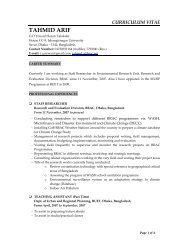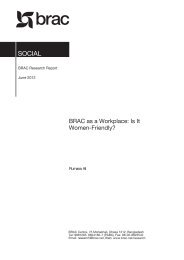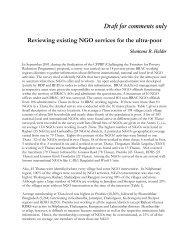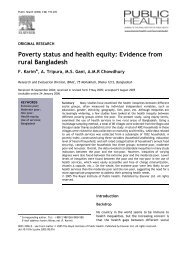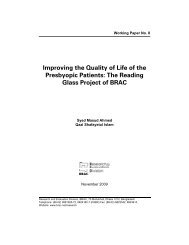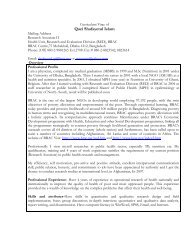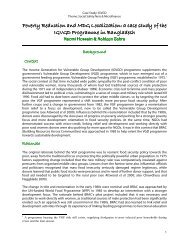Combining health and social protection measures to reach the ultra ...
Combining health and social protection measures to reach the ultra ...
Combining health and social protection measures to reach the ultra ...
You also want an ePaper? Increase the reach of your titles
YUMPU automatically turns print PDFs into web optimized ePapers that Google loves.
Decision-making<br />
Europe <strong>and</strong> Central Asia<br />
Latin America <strong>and</strong> Caribbean<br />
1 Ischaemic heart disease 15.9% 1 Perinatal conditions 6.0%<br />
2 Cerebrovascular disease 10.8% 2 Unipolar depressive disorders 5.0%<br />
3 Unipolar depressive disorders 3.7% 3 Violence 4.9%<br />
4 Self-inflicted injuries 2.3% 4 Ischaemic heart disease 4.2%<br />
5 Hearing loss, adult onset 2.2% 5 Cerebrovascular disease 3.8%<br />
6 Chronic obstructive<br />
pulmonary disease 2.0% 6 Endocrine disorders 3.0%<br />
7 Trachea, bronchus, lung cancers 2.0% 7 Lower respira<strong>to</strong>ry infections 2.9%<br />
8 Osteoarthritis 2.0% 8 Alcohol use disorders 2.8%<br />
9 Road traffic accidents 1.9% 9 Diabetes mellitus 2.7%<br />
10 Poisonings 1.9% 10 Road traffic accidents 2.6%<br />
Sub-Saharan Africa<br />
Middle East <strong>and</strong> North Africa<br />
1 HIV/AIDS 16.5% 1 Ischaemic heart disease 6.6%<br />
2 Malaria 10.3% 2 Perinatal conditions 6.3%<br />
3 Lower respira<strong>to</strong>ry infections 8.8% 3 Road traffic accidents 4.6%<br />
4 Diarrhoeal diseases 6.4% 4 Lower respira<strong>to</strong>ry infections 4.5%<br />
5 Perinatal conditions 5.8% 5 Diarrhoeal diseases 3.9%<br />
6 Measles 3.9% 6 Unipolar depressive disorders 3.1%<br />
7 Tuberculosis 2.3% 7 Congenital anomalies 3.1%<br />
8 Road traffic accidents 1.8% 8 Cerebrovascular disease 3.0%<br />
9 Whooping cough 1.8% 9 Vision disorders, age-related 2.7%<br />
10 Protein-energy malnutrition 1.5% 10 Cataracts 2.3%<br />
South Asia<br />
East Asia <strong>and</strong> Pacific<br />
1 Perinatal conditions 9.2% 1 Cerebrovascular disease 7.5%<br />
2 Lower respira<strong>to</strong>ry infections 8.4% 2 Perinatal conditions 5.4%<br />
3 Ischaemic heart disease 6.3% 3 Chronic obstructive pulmonary disease 5.0%<br />
4 Diarrhoeal diseases 5.4% 4 Ischaemic heart disease 4.1%<br />
5 Unipolar depressive disorders 3.6% 5 Unipolar depressive disorders 4.1%<br />
6 Tuberculosis 3.4% 6 Tuberculosis 3.1%<br />
7 Cerebrovascular disease 3.2% 7 Lower respira<strong>to</strong>ry infections 3.1%<br />
8 Cataracts 2.3% 8 Road traffic accidents 3.0%<br />
9 Chronic obstructive<br />
pulmonary disease 2.3% 9 Cataracts 2.8%<br />
10 Hearing loss, adult onset 2.0% 10 Diarrhoeal diseases 2.5%<br />
Table 9: Leading causes of burden of disease in low- <strong>and</strong> middle-income countries, by region, 2001<br />
among men. The number of cases of lung cancer increased<br />
nearly 30% since 1990, largely reflecting <strong>the</strong> emergence of<br />
<strong>the</strong> <strong>to</strong>bacco epidemic in low- <strong>and</strong> middle-income countries.<br />
S<strong>to</strong>mach cancer, which until recently was <strong>the</strong> leading site<br />
of cancer mortality worldwide, has been declining in all parts<br />
of <strong>the</strong> world where trends can be reliably assessed, <strong>and</strong> in<br />
2001 caused 842 000 deaths, or about two thirds as many<br />
as lung cancer. Liver cancer was <strong>the</strong> third leading site, with<br />
607 000 deaths in 2001, more than 60% of <strong>the</strong>m in <strong>the</strong><br />
East Asia <strong>and</strong> Pacific region. Among women, <strong>the</strong> leading<br />
cause of cancer deaths was breast cancer. Breast cancer<br />
survival rates have been improving during <strong>the</strong> past decade,<br />
but <strong>the</strong> chance of survival varies according <strong>to</strong> <strong>the</strong> coverage of<br />
<strong>and</strong> access <strong>to</strong> secondary prevention. Globally, neuropsychiatric<br />
conditions accounted for 19% of <strong>the</strong> disease burden among<br />
adults, primarily from nonfatal <strong>health</strong> outcomes.<br />
Injuries: <strong>the</strong> hidden epidemic<br />
Injuries, both unintentional <strong>and</strong> intentional, primarily affect<br />
young adults, <strong>and</strong> often result in severe, disabling sequelae.<br />
In 2001, injuries accounted for 16% of <strong>the</strong> adult burden of<br />
ill-<strong>health</strong> <strong>and</strong> premature death worldwide. In parts of Latin<br />
America <strong>and</strong> <strong>the</strong> Caribbean, Europe <strong>and</strong> Central Asia, <strong>and</strong> <strong>the</strong><br />
Middle East <strong>and</strong> North Africa more than 30% of <strong>the</strong> entire<br />
disease <strong>and</strong> injury burden among male adults age 15 <strong>to</strong> 44<br />
was attributable <strong>to</strong> injuries, <strong>and</strong> road traffic accidents,<br />
violence, <strong>and</strong> self-inflicted injuries were all among <strong>the</strong> <strong>to</strong>p 10<br />
leading causes of <strong>the</strong> burden of disease. Globally, road traffic<br />
accidents were <strong>the</strong> third leading cause of burden in <strong>the</strong> same<br />
age <strong>and</strong> sex group, preceded only by HIV/AIDS <strong>and</strong> unipolar<br />
depression. The burden of road traffic accidents has been<br />
increasing, especially in <strong>the</strong> developing countries of sub-<br />
Saharan Africa <strong>and</strong> South <strong>and</strong> Sou<strong>the</strong>ast Asia, <strong>and</strong><br />
particularly affects males.<br />
Intentional injuries, which include self-inflicted injuries <strong>and</strong><br />
suicide, violence, <strong>and</strong> war, accounted for an increasing share<br />
of <strong>the</strong> burden, especially among economically productive<br />
young adults. In developed countries, suicides accounted for<br />
<strong>the</strong> largest share of <strong>the</strong> intentional injury burden, whereas in<br />
developing regions, violence <strong>and</strong> war were <strong>the</strong> major sources.<br />
The former Soviet Union <strong>and</strong> o<strong>the</strong>r high-mortality countries of<br />
Eastern Europe have rates of death <strong>and</strong> disability resulting<br />
from injury among males that are similar <strong>to</strong> those in sub-<br />
Saharan Africa.<br />
Regional variations in <strong>the</strong> burden of disease<br />
Table 9 summarizes <strong>the</strong> 10 leading causes of burden for each<br />
of <strong>the</strong> low- <strong>and</strong> middle-income regions.<br />
In 2001, IHD <strong>and</strong> stroke dominated <strong>the</strong> burden of disease<br />
in Europe <strong>and</strong> Central Asia, <strong>and</strong> <strong>to</strong>ge<strong>the</strong>r accounted for more<br />
Global Forum Update on Research for Health Volume 4 ✜ 173




